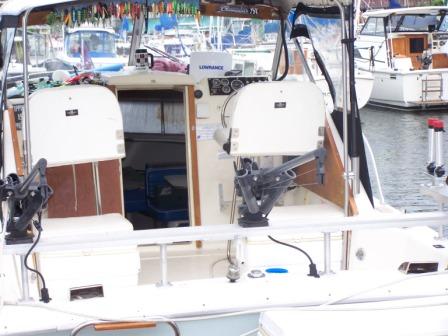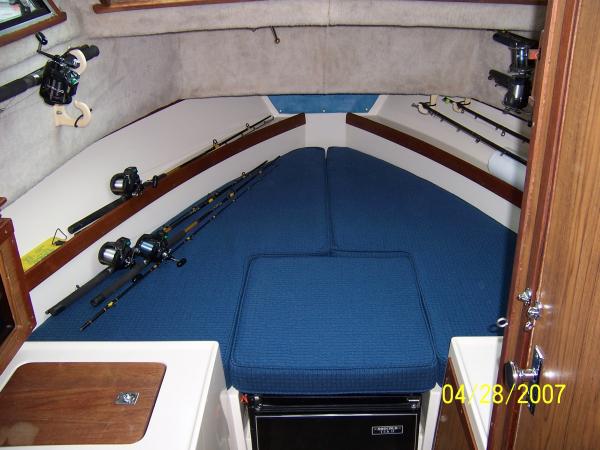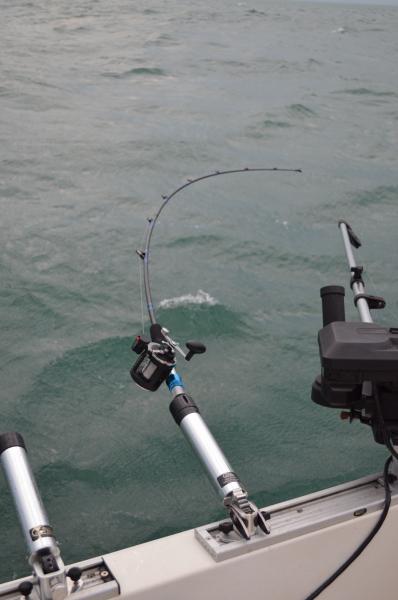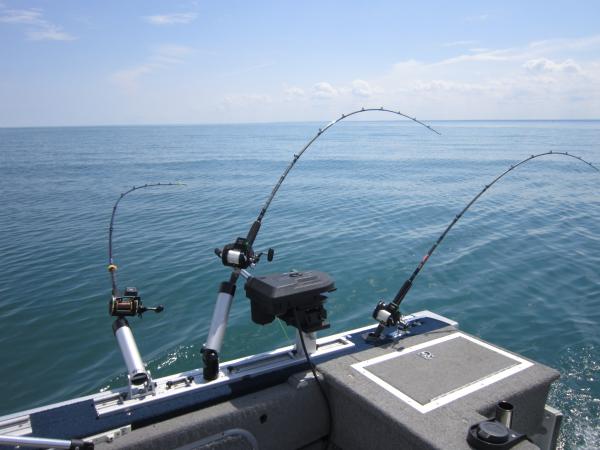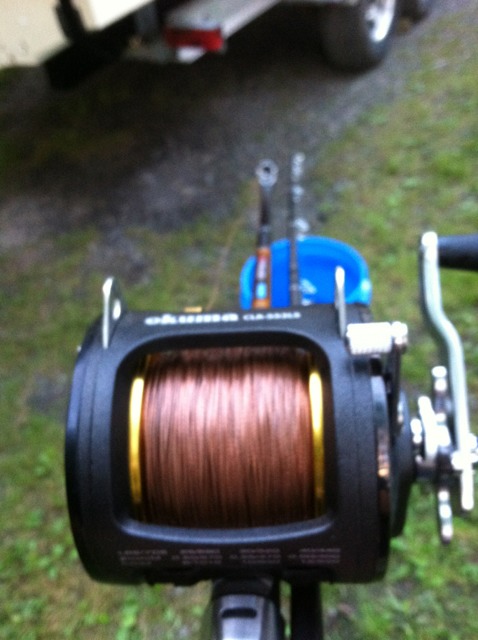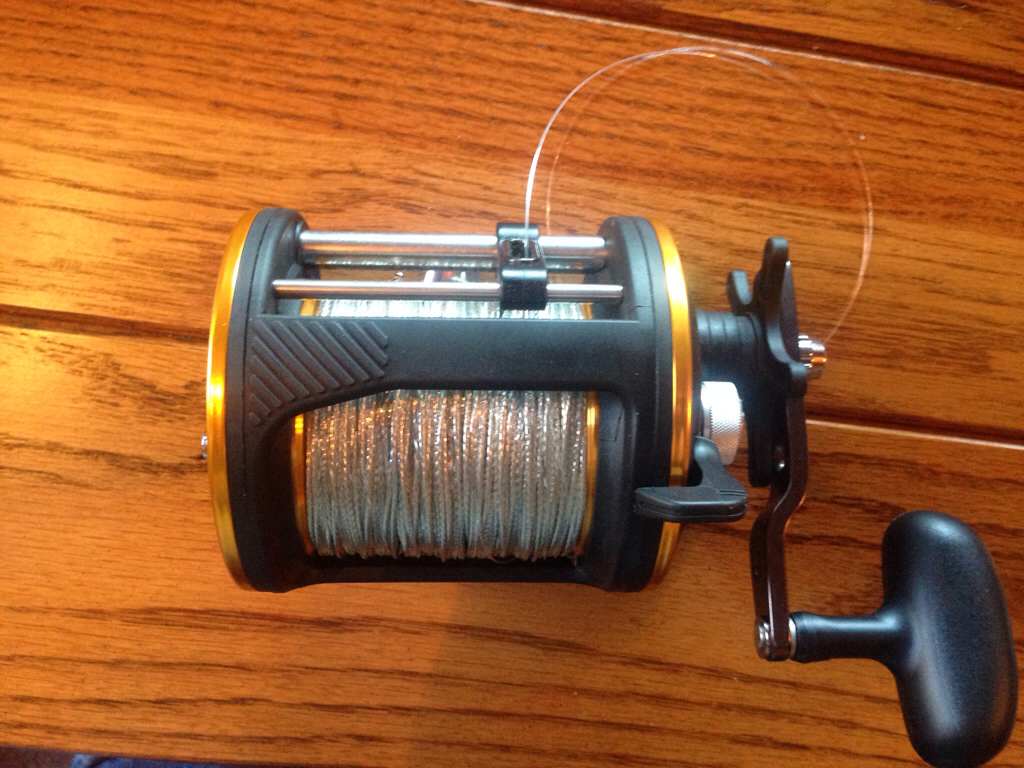-
Posts
784 -
Joined
-
Last visited
Content Type
Profiles
Forums
Events
Gallery
Store
Everything posted by John E Powell
-
I was going to write a response, and while I was doing so, the person directly above me wrote and posted a more detailed and better response, so I deleted mine.. Just ignore this as I can't seem to totally delete this post.
-

Penn Yan Tunnel drive for Trolling?
John E Powell replied to dvdegeorge's topic in Open Lake Discussion
A properly sized set of trolling bags will get that boat to the right speeds when running the main or auxiliary engine no problem. As to auxiliary power and steering, I'm confident one of the high thrust 10-15 hp engines and a maximum thrust propeller would push this along nicely, but steering with the main rudder and auxiliary locked down the center just isn't going to work. There is no thrust of water from the propeller against the surface of the rudder; this is how steerage is accomplished at low speeds on rudder-steered boats. Having never done this myself, i believe you will have to either connect the outboard to the main steering system by a mechanical or electronic means, or come up with a secondary dedicated steering system altogether. In either case, the integration of a good autopilot would be a welcome addition at the same time your are sorting all this out. I'm sure this has been done by many people as that is a pretty popular boat. Hopefully, someone will chime up with actual experience and be able offer more detailed info. -

Penn Yan Tunnel drive for Trolling?
John E Powell replied to dvdegeorge's topic in Open Lake Discussion
Vince had a nice response to a similar question recently, check it out here: http://www.lakeontariounited.com/fishing-hunting/topic/39087-penn-yan-pocket-drive/?hl=%2Btunnel+%2Bdrive#entry250005 -

For Sale : USA 1976 Chriscraft
John E Powell replied to DGH23's topic in Classifieds - Buy, Sell, Trade or Rent
-
I have a lot of Garmin gear on my boat, all at least a few years old now and still working great. I have both the NMEA 2000 network and the Garmin proprietary network. Everything talks to everything else. It's basically just plug and play. When new software updates are available, I download them to a SD card with my laptop; then at the boat, I just power everything up and slip the SD card into either of my SD ports (I have 2 display units) and every Garmin device on my network is automatically detected and the software update is applied. I used to be a Lowrance fan going way back to when Lowrance used to have the free service and repair clinics in conjunction with the ESLO derbies. It seems like when they stopped doing that, they changed their overall corporate service model and disgruntled many people. Lowrance let their excellent reputation they built slip away and people started to look for and find better products and support from companies like Northstar, Furuno, Raytheon, Simrad, and SiTex/Koden. Garmin entered the marine market a while back already a leader in the GPS industry. They understand that the customer service business model Lowrance seems to cling to won't work well in today's market. I used to be a strong Lowrance supporter, but they have lost me as a customer probably for life.
-

Wanted High Quality GPS
John E Powell replied to Fishstix's topic in Classifieds - Buy, Sell, Trade or Rent
Since you seem to be willing to discard this unit, have you tried to dismantle it and fix it? If you break it, you haven't really lost anything. Just an idea. -

for sale : usa Revised and Reduced- 25' Grady White Sailfish/Closed
John E Powell replied to UpGrady's topic in Boats for Sale
Prices can vary widely on slips. Old marinas with few upgrades over the years with lots of open slips may have really cheap slips available while high profile marinas with extensive facilities could be $3-4k for a boat this size. Sterndrive boats are more complex than inboards and require additional maintenance that is not too difficult to perform. When considering the purchase of a used boat, always have the hull professionally surveyed and have the engines and drives inspected by a mechanic certified on that drive system. They will give you the best assessment of the current condition and future maintenance needs of a particular boat. To answer your question with an estimate figure 3.5-5k per year plus fuel. -

spin doctor videos?
John E Powell replied to john1947's topic in Questions About Trout & Salmon Trolling?
With 8" SD, I start out at 23" from front of the fly, 2.2 downspeed set 8' from the ball. -
For me that would be a no brainer, Garmin CHIRP.
-
Having fished with them all, my vote has to go with the Okuma Catalina 305da. The tension spool control system, a secondary drag, can be set to keep drag tension on the spool when the main drag is disengaged. This all but eliminates wire birdnesting when someone free spools a reel under tension by accident. It also allows you to creep a dipsy out under tension without adjusting the main drag setting. The engagement of the main drag, if a fish hits while the diver is creeping out, can be activated by flipping the spool control lever or by simply turning the reel handle (engaging the main drag). The second big advantage for some people is the location of the counter on top of the reel. Some reels have the counter on the left and can be very uncomfortable to reach around. This is a more important consideration if rods will be used by children, women, the elderly, or by people who suffer from forearm or wrist afflictions like arthritis or nerve pain.
-

Short vs long rods
John E Powell replied to Goatboy's topic in Questions About Trout & Salmon Trolling?
I fish occasionally on a friends boat who has transitioned away from 4 downriggers to 2 downriggers. He often runs 4 divers (2 mag and 2 regular) on wire line. He's able to run 7' inside rods and 8' outside rods. On my boat, I have a Whaler Drive (a large outboard bracket) that requires me to run my riggers a little further out. Even so, I am able to run 8' inside mag wire divers paired with 9' outside wire divers. I have a third set of 10 footers rigged for shallower fishing using lite bite slide divers. I could run all three without problems, but in reality most of the time I do not run a charter boat spread for everything from deep kings to shallow steelhead, so I only run 2 per side targeting kings. I ether run the 8+9 for deeper fish or the 9+10 for shallower smaller fish. I've watched people fighting and landing fish on all those different length rods and have come to the conclusion that 10-10.5' diver rods are technological dinosaurs. I'll still build them for someone if they insist, but I no longer recommend them. I am seriously considering retiring all my diver rods in favor of 7' for inside wire mags, 8' wire standard, and 9' lite bites, or even two pairs of 7 and 8' rods (one pair being built for heavier deeper gear and the other pair for lighter shallower presentations). I can always rig dipsy/deeper divers as slide divers with a Big Jon Jettison release when the bite calls for a more stealthy longer lead length thus eliminating the hassle of netting fish with lengthy fixed diver leaders. Back in the 70s we ran shorter offshore or musky style rods with pink ladies but transitioned in the 80s to the super long rods. Lacking the correct action and adequate power those downrigger actioned 9-10' rods just couldn't reach out far enough so instead of fixing the problem with a faster action and more reach before the bend, they just made the rods longer (not at all moving the bending point significantly further from the side of the boat). There were a few early attempts to do this correctly, but the combination of shorter lengths, correct action, adequate but not excessive power and extreme durability eluded rod manufacturers until only recently. Finally, after a 30+ year transition to longer and longer rods, we're as a fishery transitioning back to shorter more realistic mass manufactured rods. The new MHX DR845 blank is truly the best blank ever made for rigger and big board copper/leadcore rigs. Now if someone could just make the perfect diver blank I would be a happy camper. Unfortunately I don't think that is possible yet with the materials available to construct blanks with. There needs to be a major push and the market for diver rods are just too small to justify the expense. Until that happens, we'll just have to make the best with what we have. -

Short vs long rods
John E Powell replied to Goatboy's topic in Questions About Trout & Salmon Trolling?
You really only need rods long enough to do the job. For some boats this means 6.5-7'. Other boats will need longer rods in the 8-9' range. Very few, if any need longer than this unless you run multiple divers per side. Having the correct action, mod/fast to fast, in the right power range to be properly loaded by the drag setting and diver and bait of your choice is far more important than rod length as long as the rod is long enough to clear your rigger cables. As a custom rod builder, I can tell you that the most challenging trolling rod to build is a good diver rod. Most people think they need a longer diver rod than they really do. All a longer rod than necessary accomplishes is to needlessly tire the angler using it. A fishing rod is a lever and the fisherman is on the wrong end of that lever. Long rods just make the lever ratio more powerful for the fish. Long rods lengthen the time it takes to land fish so more fish will die if you are into catch and release. Tournament fisherman lengthen the time a rod is occupied and cannot be reset with longer rods. I could give many more examples along these lines. If you are happy with your 6' rods and they work for your setup, then use them and don't worry about what other people are using. -
Seems to me like the lack of an overhand knot to lock the tag end would be a weakness, especially if the knot is pulled to the rod tip regularly are care was not taken to cinch the wire down tight. I would have a lot more confidence with the LOTSA / Ernie Lantiegne knot that takes the extra step of tying an overhand knot to lock and control the tag end down.
-
It sounds like you have a two downrigger setup and 4 wire divers? If so, and assuming the lake hasn't flipped, that will be fine until the sun is up mid morning. As long as you're marking large salmon on your sounder, target those depths with your baits (don't worry at this time of the year if the fish are out of preferred temperature). Once midmorning arrives and the fish seem to disappear, then you might want to consider changing out the inside mag divers for lead ball rigs. Rig them on a three-way setup with 18-24" drop on the 1lb. ball and pull the attractor so the ball just tick bottom now and then. At this time of the year I generally prefer dodgers to rotating flashers. I'd rig glows in the early morning and transition to chartreuse/white/pearl as the sun comes up. I run them on every rod and will stack them two per rigger when I switch to a bottom oriented program midmorning. I will also be running about 1.6-1.8 downspeed when trying to trigger strikes from territorial salmon. So while marking fish in the early am, chase them with a traditional setup, but once they "disappear" and the fleet begins to head North, stay in the same waters and change over to a bottom program with 2 lines on each rigger and 2 bottom bouncing rigs.
-
-
The high speed is a nice improvement, pits it squarely against the Clarion 553 but with greater capacity. Nice job overall, and at an atractive price if it functions well. Maybe Daiwa will come out with a larger size or a wide frame version with higher capacity for the really deep coppers. Would be nice to have a competitive high speed option to the Solterra 50L and Penn Senators.
-
You don't like my duck analogy? Haha...
-
Mup I guess stands for mommy and hurry up. Basically mommy baitfish is out front and jr is trailing behind trying to keep up. Depending on the time of the year, this could be a large/medium combo or a medium/small combo on a rigger. The baits are placed in relative close proximity to each other with the larger bait forward and the smaller bait trailing. On a single rod, the smaller lure would go on the mainline say 10' behind the ball, and the larger bait would go on a fixed stacker a few feet above and forward (due to shorter stacker leader length) of the mainline bait. You can get a similar effect further back using two rods. If you picture mommy duck swimming with the baby ducks trailing close behind, you can get a visual image of the concept. Every once in a while, a pike or musky might snatch a trailing baby duck. Same concept here...
-

ever clip on your dipsy
John E Powell replied to joewallguy's topic in Questions About Trout & Salmon Trolling?
No, but I sometimes use a Big Jon jettison release and large split ring to turn a dipsy into a slide diver and get a similar effect. This setup will trip so you don't have to bring in an untripped dipsy. -
My opinion is that anything over 7' on non-chute copper rod is not only unnecessary, but is also very tiresome to the angler. I believe this is why so many people have love/hate relationships with their copper rigs. They choose rods that are too long, and reels that are too slow then grumble and complain about them.
-
It's not just gear ratio, you have to take into account spool diameter filled to full point. What you want to know is retrieve of line in inches per turn of the handle when the reel is full (which by the way lessens with every pass of copper removed from the reel). On reels that do not hold adequate backing, like only 50-100 yds, the diameter of the backing on the reel's spool is so small that you may be getting only a foot +/- of retrieve per turn even though the reel tech info may say 2 foot or more per turn. It can take, for example 450 turns of the handle, with no drag slip, just to bring in a 600 ft copper. Now add a rampaging king into the mix, peeling off line, and turns of the handle where there is drag slippage and you could easily turn that handle crank 1000 times or more before the fish is netted on a standard retrieve ratio reel. With an oversized reel, when you let out all the copper, you have 200-300 yds of backing, compared to a smaller reel's 50-100 yds, and the bigger reel's backing diameter, compared to a smaller reel, is much larger. This means, somewhat confusingly, that a large reel with a full reel retrieve of 28 inches per turn may actually bring in a long fully deployed copper quicker than a smaller reel with a faster 30" retrieve.
-
While this is true and I would agree with you if you fished just a few times a year, that is not the main reason people upgrade to a roller or twili tip. Wire line and rod tip wear is a two-way streak; repeatedly running wire across the tiny radius of a standard rod tip cause premature wear to the wire causing it to curl excessively. These curls can loop over themselves and kink, and kinked wire breaks. Given a spool of wire, diver, attractor, fly, fluorocarbon leader and swivels run about $75 on a typical diver rod, a twili or roller tip upgrade is a fraction of the cost of a kinked and broken line.
-
For spring kings and summer bows, look over the chart and select a 30lb. setup to target the 30-50 depths. At these shallower depths, choosing 30lb. copper will allow you to use a smaller lighter reel than the thicker and heavier coppers. Keep in mind that these depths on the charts were using a mag spoon and when using an attractor your depth will be 10-20% less due to the added drag. The Okuma Clarion 553 high speed is a great reel for this setup. If you happen to have a Convector already, you can change out the stock gears and install a set of Clarion gears. Upgrading to premium aftermarket carbon fiber drags at the same time would make some great reels for not a lot of additional money. The Tekota 700 is a good reel too, but do yourself a favor and change out the drags as the stock drag on the 700/800 reels is pretty bad; once upgraded, they are great reels. For summer kings, I would select a 45 or 60lb. copper to reach 50-70 foot and a 60lb. copper to reach the 70-90 depths. The big advantage of the heavier copper is that you have to let out less line (and reel less line back in) to get to the same depths. For example, I'd much rather reel in 400' of 60lb. than 600' of 45lb. You'll need a really large reel for the longer setup; Penn 345 and Okuma Solterra 50L. For me, The Tekota 800 doesn't have enough capacity to have adequate backing for a really deep rig. Other people here will disagree with me on this, but I want to have 200 yards or more of backing. I have a deeper rig than these, but it's a beast... Penn Senator with 500' of 60lb. copper and lots of backing. My point here is to suggest to you that you want to use reels with really large capacity to have adequate backing. For rods, I suggest no more than 7' for planer board rods, but 8-9 foot is better for a chute rod down the middle; the longer length makes it easier to maneuver around riggers when landing fish on other rods, but it will tire the angler more than a shorter rod and most people will find it heavy handed. The main reason most people hate the longer coppers is they are using inexpensive reels with slow retrieve rates and they are using rods that are too long that tire the fisherman more than the fish.
-

Rod blanks for Laker jigging rods
John E Powell replied to uglyokuma's topic in Tackle and Techniques
I can help you find the right blank for any Great Lakes trolling application. Lots of choices for great downrigger rods. There are fewer good diver rod choices. Send me a private message describing what you are looking for and I help point you in the right direction.


